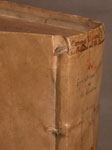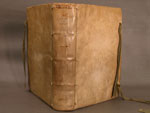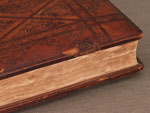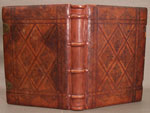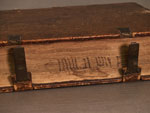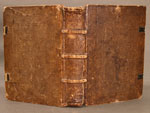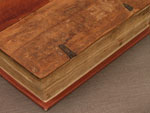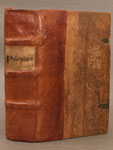15th Century: The Book in Transition
Bookbinding came out of the dark ages as European culture began to flourish. Books became more common with the invention of printing mid-century. Very different styles of bindings developed in northern and southern Europe, differences which would be evident for the next few centuries. The books shown here bridge the medieval book and the structure of the book which would last until the 19th century.
- Title:
- Scriptores rei rusticae.
- Publisher:
- Reggio Emilia : Bartholomaeus and Laurentius de Bruschis, Bottonus, June 5, 1482.
- Call Number:
- PA 6139 .R8 1482
A southern European binding in vellum. The ends of the sewing supports, called slips, can be seen laced through the binding at the hinge. The cloth ties were used to hold the book closed, since vellum tends to warp when the humidity changes.
- Author:
- Bartholomaeus, Anglicus, 13th cent.
- Title:
- De proprietatibus rerum.
- Publisher:
- Nuremberg, Anton Koberger, 20 June 1492.
- Call Number:
- AE 2 .B3 1492 c.1
A northern European binding in full leather. The diapered pattern (i.e. the diagonals) are fairly typical of this era of binding. There were clasps to hold the book shut, which are now missing. The wood of the boards, most likely beech or oak, can be seen in the split in the leather.
- Author:
- Voerda, Nicasius de, d. 1492.
- Title:
- Lectnra [sic] libri Institutionn[m] [i.e. Institutionum] magistri Nycasij de voerda ... Iustinianus.
- Publisher:
- [Cologne] : ... Industria Iohannis Koelhoff ..., 1493
- Call Number:
- KJA 1925 .N52 A36 149
A northern European binding in full leather with blind tooling on the cover. The title can be seen on hand-written on the fore edge, rather than tooled on the spine. The wooden boards are exposed at the corners.
- Author:
- Filelfo, Francesco, 1398-1481.
- Title:
- Epistolae.
- Publisher:
- [Basel, Johann Amerbach, ca. 1496]
- Call Number:
- PQ 4621 .F45 Z5 A3
A southern European binding bound in quarter leather with exposed wooden boards. Binders in southern Europe tended to use beech. The large ridges on the spine cover the sewing, mostly likely on split alum-tawed thongs. A vellum title label has been glued to the spine. There are evidence of claps on the front board. The back board has been lost and replaced with a cloth replacement.

